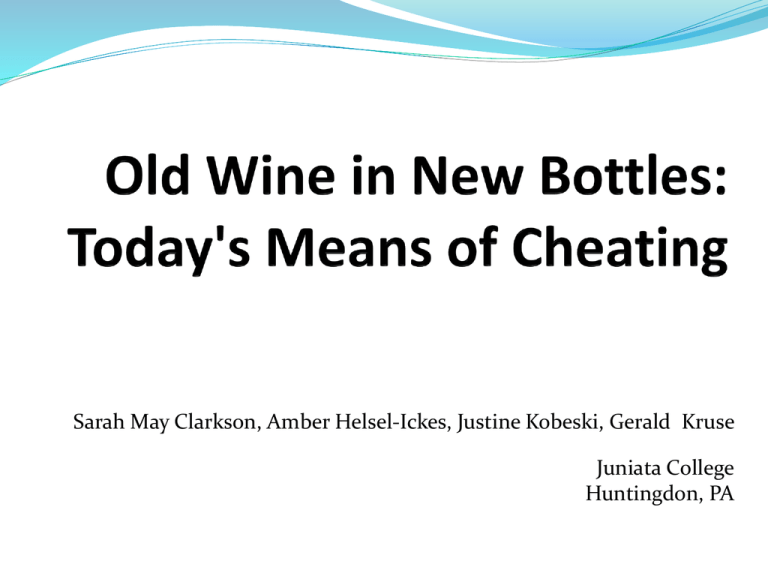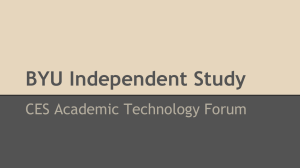SoTL Brown Bag - Juniata College
advertisement

Sarah May Clarkson, Amber Helsel-Ickes, Justine Kobeski, Gerald Kruse Juniata College Huntingdon, PA Case Study 1 • You teach a course with an “H” designation, it has a pre-req, but less than 300-level. • Roughly half of the students are taking the course for the upper-level “H” distribution credit. • Student Assessments include: (1) mid-term exam, (2) final exam, (3) small group work w/a short presentation, (4) class participation, and (5) an 8 page research paper. • The research paper project is designed to avoid end-of-semester stress: • A topic proposal is due week 4 • An annotated bibliography (lite for non-H POEs) is due week 6 • A substantial first draft is discussed at a paper conference weeks 8 and 9 • Final draft is due mid-November Case Study 1 continued Student “Ron” – bright, but struggling: initial topic is too broad, but was addressed in office hours, and the annotated bibliography is “sketchy at best.” Case Study 1 continued You allow the student to change topics The final paper is submitted on time You are suspicious of its originality and authenticity BUT This is the first and only draft you have seen Google searches on various passages don’t reveal any matches You provide reference librarians a copy of the anonymized paper with the troublesome passages highlighted The librarians find passages lifted without attribution from a very small academic journal, maybe 10 or 12 lines in a 6-page paper Case Study 1 continued Discuss among yourselves (~3 – 5 minutes): Poll Everywhere: http://www.polleverywhere.com/multiple_choice_polls/ 4GMKU6Y6GpSMen3 What is the reason for your choice? What would your next step be? Juniata’s Academic Integrity Process (detailed in Pathfinder and on the Provost’s web-page) The faculty member should first contact the Asst. Provost. The Asst. Provost will review the case information, clarify questions the faculty may have about the process, and guide the faculty member in the next steps. If there is sufficient evidence to move forward, then the faculty member will be asked to contact the student(s) involved, and the Asst. Provost then emails blank allegation sheet to faculty. 1.Faculty completes allegation sheet, which includes the assigned penalty, and emails to Asst. Provost. 2.Asst. Provost emails PDF version of allegation sheet to student and faculty and sets up meeting , which happens at least three class days after the student is presented with the allegations. 3.At the meeting, the allegations are presented to the student, with an opportunity for discussion. The student then chooses between: Admitting to the allegation and accepting the penalty Admitting to the allegation but disputing the penalty* Denying the allegation* * - case proceeds to Judicial Board hearing Examples of Academic Dishonesty 1. Cheating: 2. Plagiarism: 3. Fabrication and Falsification: 4. Multiple Submission: 5. Abuse of Materials: 6. Complicity in Academic Dishonesty: 7. Failing to cooperate Examples of Academic Dishonesty 1. Cheating: using or attempting to use unauthorized material in any academic exercise. This can include using unauthorized materials (e.g., notes, examination copies, electronic sources), having or accessing unauthorized materials during the examination time, or going against explicit instructor directions for the completion of an assignment or exam. 2. Plagiarism: presenting another’s work (i.e., ideas, representations, or words) as one’s own without proper acknowledgment of the source. 3. Fabrication and Falsification: altering or inventing any information or citation in any academic exercise. 4. Multiple Submission: submitting substantial portions of the same academic work for credit more than once without authorization. 5. Abuse of Materials: damaging, destroying, stealing, or in any way obstructing access to library or other academic resource material or academic records. 6. Complicity in Academic Dishonesty: intentionally helping or attempting to help another commit an act of academic dishonesty; unauthorized collaboration on any academic work. 7. Failing to cooperate in the investigation of any student being accused of academic dishonesty. Diagnostics You provide reference librarians a copy of the anonymized paper with the troublesome passages highlighted File Authorship What other methods do you use? Preventative Measures What could have been done differently by the student and/or faculty member in this case? What preventative measures can we consider in our classes? Message to students in the Pathfinder Look at all your course syllabi carefully. Understand that you will sign an Agreement about the ethical use of the computer. This is very, very serious: if you present someone else's intellectual property as your own, that is stealing. Ask questions of your professors: How much collaboration is permissible? How do I cite this kind of material: Do you allow students to use references found on the World Wide Web? Each student's Juniata College degree is diminished by cheating. Don't do it. Please realize that cases of confirmed academic dishonesty could ruin hopes of a career in medicine, education, social work, or law enforcement. TurnItIn Info warning: copied and pasted from http://en.wikipedia.org/wiki/Turnitin Turnitin is an Internet-based plagiarism-prevention service (FERPA and COPPA compliant). Typically, universities and high schools buy licenses to submit essays to the TurnItIn website (also has integration with Moodle), which checks the documents for unoriginal content. The results can be used to identify similarities to existing sources or can be used in formative assessment to help students learn how to avoid plagiarism and improve their writing. Response to TurnItIn “Citation practices like every other element of good writing have to be taught, and in writing courses where those practices are supposed to be taught, sometimes a pedagogical response is appropriate rather than a punitive response. My concern with PDS's is that they send the wrong message to students and set up an adversarial relationship between students and teachers. Like every other tool, there are certain things they can show us and certain things they cannot show us, and I am hesitant to embrace them because I think I can teach citation practices to my students better than the technology can, and because I don't want writing courses to turn in to policing students to make sure they're not cheating.” Hannah Bellwoar See also: http://www.insidehighered.com/news/2013/04/16/writing-professors-question-plagiarism-detection-software TurnItIn Higher Ed Campus fee - $1000 annually System Admin set-up Fee - $5000 one-time fee TurnItIn with Moodle integration $2.75 x full headcount, annual charge for unlimited access TurnItIn Standalone $2.30 x full headcount, annual charge for unlimited access Compatible File formats Microsoft Word™ (DOC and DOCX), Corel WordPerfect®, HTML, Adobe PostScript®, Plain text (TXT), Rich Text Format (RTF), Portable Document Format (PDF), Hangul (HWP) at this time, no Excel, Maple, or Minitab… Poll Everywhere What do you think of TurnItIn? http://www.polleverywhere.com/multiple_choice_polls/ DmHvZKJ9O4ALrgG Questions / Discussion / Policy Thoughts TurnItIn Info warning: copied and pasted from http://en.wikipedia.org/wiki/Turnitin Students may be required by schools to submit essays to Turnitin, as a deterrent to plagiarism. This has been a source of criticism, with some students refusing to do so in the belief that requiring it constitutes a presumption of guilt. Additionally, critics have alleged that use of the software violates educational privacy and intellectual property laws. Stages of Institutional Development http://www.academicintegrity.org/icai/home.php Stage One: "Primitive" Stage Two: "Radar Screen" Stage Three: "Mature" Stage Four: "Honor Code" Case Study 2 You teach a 100-level math class (with apologies to our dear mathematicians). When you look out at the sea of faces, the students represent the full range and variety (pre-health types, physics and engineering students, those earning their QM credit, and a few exploring), but very few majors. So you are providing a service, an important one. Case Study 2 continued As always in a class of 35 or 40, about 5 or 10 request peer tutoring, which you agree to, but encourage these students to come to office hours as well. One such student got tutoring after two very weak tests and crappy lab/homework grades. She has a friend who tutors in math, so when she filled out the tutoring request, she asked to be matched, if possible, with her friend. The next test improves by 20 points, and it looks like she could pass, which she needs to do for two reasons: this class is a specific requirement of her POE and she’s a first-semester senior who has no wiggle room to add this class to her spring schedule if she fails it or has to withdraw. Case Study 2 continued Her tutoring arrangement is actually a small group, which she agreed to because the other tutee is a friend, though she’s in a different section. At one such session, the tutor works individually with each student and because of time constraints and having to focus from one student to the next, mistakenly provides too much help to our one student on her homework assignment. The tutor hadn’t asked specifically what was being worked on and thought it was practice or a practice test. Case Study 2 continued You are surprised that the student does well on this particular homework assignment because she was absent both days that the material was covered in class. You know she’s not confident enough in the material to submit successful answers without class attendance. You turn the homework back without a grade and ask the student to see you during office hours, which she does. You ask how she determined the answers, especially when she had been absent twice the previous week. She told you, truthfully, that the tutor helped her.


